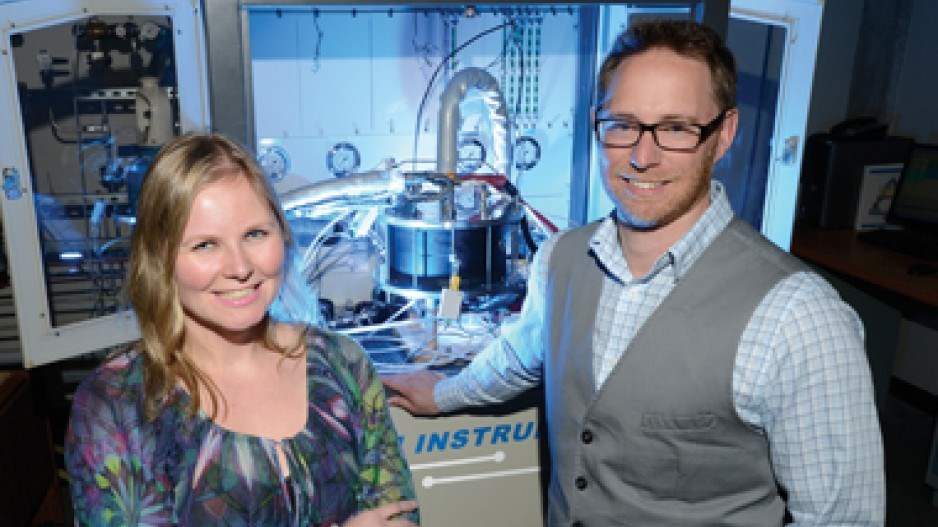One of the biggest barriers to greater adoption of hydrogen fuel cell technology is cost.
Not only is hydrogen more expensive than gasoline, diesel and natural gas, the fuel cells themselves are expensive.
A Vancouver company that has been quietly working on fuel cell efficiency since 2001 claims it has a solution that could bring the cost of hydrogen fuel cells down by 25% and has chosen this week’s Hydrogen and Fuel Cells Conference 2013 to go public.
The biennial conference, organized by the Canadian Hydrogen Fuel Cell Association, will draw more than 600 fuel cell scientists and business leaders from 40 countries to Vancouver.
PowerDisc will be among the Canadian companies demonstrating their technology at the conference.
The company’s eFlow technology addresses one of the problems inherent in hydrogen fuel cells: an uneven consumption of oxygen and resulting unequal distribution of current, which requires manufacturers to overbuild fuel stacks to make up for the inefficiency.
“We’ve gone through a series of validations, and we are confident that the technology functions,” said Sean MacKinnon, PowerDisc’s chief scientist. “The main objective is to let everybody know that uniform current density is now available to them.”
Based out of the National Research Council of Canada’s fuel cell institute at University of British Columbia, PowerDisc’s 10-member team includes four former Ballard Power Systems (TSX:BLD) scientists, including MacKinnon, who has also worked as a research scientist with General Motors (NYSE:GM).
Fuel cells are expensive in part because the catalyst used in most fuel cells is platinum, which costs about $1,480 per ounce.
In addition, uneven current distribution on fuel cell cathodes means they don’t function at full potential. Manufacturers therefore have to pack more fuel cells into each fuel cell stack to compensate.
“If your stack can put out 25% more power, then you can pull 25% of those units out of the stack,” MacKinnon said. “So you can essentially drop the price by a quarter.”
“If a company is saying it can reduce the number of fuel cells needed, and that translates to lowering the amounts of platinum, then right there there’s a significant cost saving,” said Steven Holdcroft, professor of chemistry at Simon Fraser University.
Hydrogen fuel cells work on the principle that hydrogen ions want to bond with oxygen atoms to form H2O – water.
Proton exchange membranes (PEMs) facilitate that by allowing hydrogen protons on one side to slip through – but not the electrons – to combine with oxygen on the other side. Knocked from their orbits, the electrons flow through an external circuit to create direct current electricity.
The problem, to date, is that as air flows into the cell, the concentration of oxygen at inlet is higher than at outlet because some of the oxygen gets used up as it combines with the hydrogen to form water. The result is that the current flowing through conducting plates is unevenly dispersed. One area of the plate will have a higher current than another area.
PowerDisc’s eFlow levels out that imbalance to create more uniform availability of oxygen and, hence, more evenly distributed current.
Hurdles facing hydrogen fuel cell adoption
Despite the obvious environmental benefits of an energy source that produces electricity and water as its only byproduct, hydrogen fuel cell technology still faces significant adoption hurdles, according to a Pike Research report commissioned by PowerDisc.
The U.S. Department of Energy has invested millions to get the average cost of proton exchange membranes down from $270 per kilowatt (kW) in 2002 to $51 per kW in 2010. Its goal is to get the cost down to $30 per kW.
Even at those costs, a hydrogen fuel cell vehicle would still cost $122,000 to make, the Pike Research report concludes, which helps explain why Ballard got out of the consumer vehicle market altogether a few years ago to concentrate on stationary power.
Ballard still makes fuel cell stacks for hydrogen buses, but has focused more on stationary power, with the biggest market being backup power for telecoms.
While Ballard says it has managed to reduce its production costs for fuel cells by 60% in the last four years, hydrogen prices will still need to drop dramatically to make the economics of hydrogen fuel cells work.




